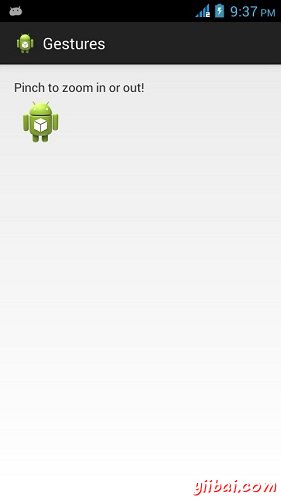Android Gestures/手势
Android提供了特殊类型的触摸屏事件,如掐,双击,滚动,长按和退缩。这些都被称为手势。
Android提供GestureDetector类接收移动事件,并告诉我们,这些事件是否有对应手势。要使用它,需要创建GestureDetector对象,然后扩展另一个类GestureDetector.SimpleOnGestureListener充当监听器,并覆盖一些方法。它的语法如下:
GestureDetector myG; myG = new GestureDetector(this,new Gesture()); class Gesture extends GestureDetector.SimpleOnGestureListener{ public boolean onSingleTapUp(MotionEvent ev) { } public void onLongPress(MotionEvent ev) { } public boolean onScroll(MotionEvent e1, MotionEvent e2, float distanceX, float distanceY) { } public boolean onFling(MotionEvent e1, MotionEvent e2, float velocityX, float velocityY) { } } }
处理捏手势
Android提供ScaleGestureDetector类来处理如:捏等手势。为了使用它,需要实例化这个类的一个对象。它的语法如下:
ScaleGestureDetector SGD; SGD = new ScaleGestureDetector(this,new ScaleListener());
第一个参数是上下文,第二个参数是事件侦听器。必须定义事件侦听器并覆盖 onTouchEvent 函数,使其工作。它的语法如下:
public boolean onTouchEvent(MotionEvent ev) { SGD.onTouchEvent(ev); return true; } private class ScaleListener extends ScaleGestureDetector.SimpleOnScaleGestureListener { @Override public boolean onScale(ScaleGestureDetector detector) { float scale = detector.getScaleFactor(); return true; } }
除了捏手势,还有其它方法 avaialible 通知的详细信息的触摸事件。它们如下:
| Sr.No | Method & description |
|---|---|
| 1 |
getEventTime() 此方法得到正被处理的当前事件的事件时间.. |
| 2 |
getFocusX() 这种方法得到的X坐标当前手势的焦点 |
| 3 |
getFocusY() 这个方法得到当前手势的焦点的Y坐标 |
| 4 |
getTimeDelta() 此方法返回在先前接受缩放事件和当前缩放事件之间的毫秒的时间差 |
| 5 |
isInProgress() 如果刻度手势正在进行此方法返回true.. |
| 6 |
onTouchEvent(MotionEvent event) 此方法接受MotionEvents并调度事件在适当的时候 |
例子
这里有一个例子演示如何使用ScaleGestureDetector类。它创建了一个基本的应用程序,放大和捏缩小。
为了试验这个例子,可以在实际设备或仿真器,触摸屏启用运行此程序。
| Steps | 描述 |
|---|---|
| 1 | 使用Android Studio创建Android应用程序,并将它命名为:Gestures。在创建这个项目,确保目标SDK编译在Android SDK的最新版本和使用更高级别的API |
| 2 | 修改src/MainActivity.java文件添加必要的代码 |
| 3 | 修改res/layout/activity_main添加相应的XML组件 |
| 4 | 修改res/values/string.xml 添加必要的字符串 |
| 5 | 运行应用程序并选择运行Android的设备,并在其上安装的应用和验证结果 |
以下是修改后的主活动文件的内容 src/com.yiibai.gestures/MainActivity.java.
package com.example.gestures; import android.app.Activity; import android.graphics.Matrix; import android.os.Bundle; import android.view.Menu; import android.view.MotionEvent; import android.view.ScaleGestureDetector; import android.widget.ImageView; public class MainActivity extends Activity { private ImageView img; private Matrix matrix = new Matrix(); private float scale = 1f; private ScaleGestureDetector SGD; @Override protected void onCreate(Bundle savedInstanceState) { super.onCreate(savedInstanceState); setContentView(R.layout.activity_main); img = (ImageView)findViewById(R.id.imageView1); SGD = new ScaleGestureDetector(this,new ScaleListener()); } @Override public boolean onTouchEvent(MotionEvent ev) { SGD.onTouchEvent(ev); return true; } private class ScaleListener extends ScaleGestureDetector. SimpleOnScaleGestureListener { @Override public boolean onScale(ScaleGestureDetector detector) { scale *= detector.getScaleFactor(); scale = Math.max(0.1f, Math.min(scale, 5.0f)); matrix.setScale(scale, scale); img.setImageMatrix(matrix); return true; } } @Override public boolean onCreateOptionsMenu(Menu menu) { // Inflate the menu; this adds items to the action bar if it is present. getMenuInflater().inflate(R.menu.main, menu); return true; } }
以下是XML的经修改 res/layout/activity_main.xml. 的内容
<RelativeLayout xmlns:android="http://schemas.android.com/apk/res/android" xmlns:tools="http://schemas.android.com/tools" android:layout_width="match_parent" android:layout_height="match_parent" android:paddingBottom="@dimen/activity_vertical_margin" android:paddingLeft="@dimen/activity_horizontal_margin" android:paddingRight="@dimen/activity_horizontal_margin" android:paddingTop="@dimen/activity_vertical_margin" tools:context=".MainActivity" > <TextView android:id="@+id/textView1" android:layout_width="wrap_content" android:layout_height="wrap_content" android:text="@string/hello_world" /> <ImageView android:id="@+id/imageView1" android:layout_width="match_parent" android:layout_height="match_parent" android:layout_below="@+id/textView1" android:scaleType="matrix" android:src="@android:drawable/sym_def_app_icon" /> </RelativeLayout>
以下是 res/values/string.xml. 的内容
<?xml version="1.0" encoding="utf-8"?> <resources> <string name="app_name">Gestures</string> <string name="action_settings">Settings</string> <string name="hello_world">Pinch to zoom in or out!</string> </resources>
以下是 AndroidManifest.xml 文件的内容
<?xml version="1.0" encoding="utf-8"?> <manifest xmlns:android="http://schemas.android.com/apk/res/android" package="com.yiibai.gestures" android:versionCode="1" android:versionName="1.0" > <uses-sdk android:minSdkVersion="8" android:targetSdkVersion="17" /> <application android:allowBackup="true" android:icon="@drawable/ic_launcher" android:label="@string/app_name" android:theme="@style/AppTheme" > <activity android:name="com.yiibai.gestures.MainActivity" android:label="@string/app_name" > <intent-filter> <action android:name="android.intent.action.MAIN" /> <category android:name="android.intent.category.LAUNCHER" /> </intent-filter> </activity> </application> </manifest>
让我们试着运行Gestures应用程序。我假设已经连接实际Android的移动设备到计算机。启动应用程序之前,会显示如下窗口,选择要运行Android的应用程序的选项。

选择移动设备作为一个选项,然后检查移动设备将显示默认屏幕:

现在只是把两个手指放在android屏幕,并且将它们分开的一部分,会看到Android的图像缩大。这显示在下面的图片:

现在,再次将两个手指在屏幕的Android,并尝试关闭它们,会看到Android的图像现在缩小。这显示在下面的图片:


